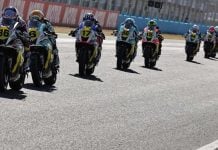FIM Road Racing World Championship Grand Prix Decision of the Grand Prix Commission The Grand Prix Commission, composed of Messrs. Carmelo Ezpeleta (Dorna, Chairman), Ignacio Verneda (FIM Executive Director, Sport), Herv̩ Poncharal (IRTA) and Takanao Tsubouchi (MSMA), in the presence of Javier Alonso (Dorna) and M. Paul Butler (Secretary of the meeting), in a meeting held on 05 November in Valence (Spain), unanimously decided the following (Changes in bold): WITH IMMEDIATE EFFECT 1.15.1.1 MotoGP Class It was agreed that with effect from 2012 private testing of MotoGP class machines may be carried out by any rider, subject to a limit on the total number of tyres being supplied by the official MotoGP tyre supplier. Final details will be confirmed at the next GPC meeting in December. It was also agreed that manufacturers may use any rider for the completion of their 2011 testing programme during November 2011. 2.3.7 7.) As an exception to Aricle 2.3.7. 6), it will be possible to break the seals if all the following conditions apply: a) the machine is entered by a CRT team, b) for the sole purpose of changing the gearbox and/or primary ratios, on an engine design where seals need to be removed for internal gearbox access, c) under supervision of the Technical Director and staff, at a time and place determined by the Technical Director. 2.5.1 The following are the revised minimum weights permitted: РMoto3: motorcycle & rider 148kg РMoto2: motorcycle 140kg РMotoGP up to 800cc motorcycle 150kg 801 Р1000cc motorcycle 153kg 2.7.3.3 In the MotoGP class, carbon brake discs must be of one size for outside diameter of 320mm and only 2 standard choices of disc mass are permitted. As an exception for the 2012 season only, machines entered by a CRT team are allowed to use carbon brake discs of other sizes. 2.7.3.4 In all classes, the proportion of ceramic composite materials in brake discs must not exceed 2% by mass. Ceramic materials are defined as inorganic, non metallic solids (e.g. Al2O3, SiC, B4C, Ti5Si3, SiO2, Si3N4). 2.7.3.5 Motorcycles must be equipped with brake lever protection, intended to protect the handlebar brake lever(s) from being accidentally activated in case of collision with another machine. Acceptable protection includes the fairing extending sufficiently to cover the brake lever, as viewed from the front. Such devices must be strong enough to function effectively and designed so that there is no risk for the rider to be injured or trapped by it, and it must not be considered a dangerous fitting (at the sole discretion of the Technical Director). In case the brake lever protection is attached to any part of the braking system (eg. brake master cylinder), then the brake system manufacturer must officially confirm in writing to the Technical Director that the device does not interfere with the proper brake operation.
MotoGP Relaxes Testing Rules, Revises Minimum Weight Limits, Mandates Brake Lever Guards
MotoGP Relaxes Testing Rules, Revises Minimum Weight Limits, Mandates Brake Lever Guards
© 2011, Roadracing World Publishing, Inc.






